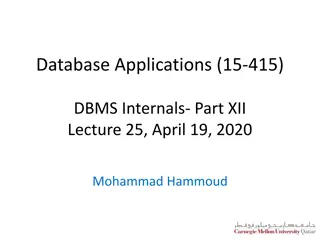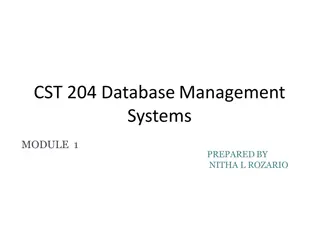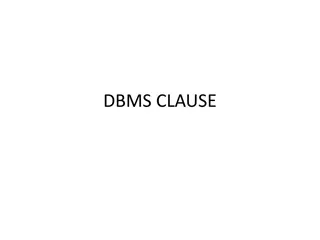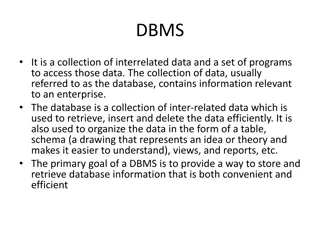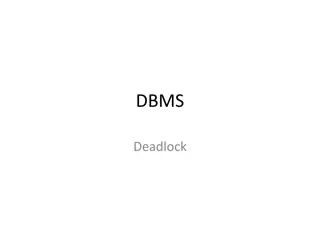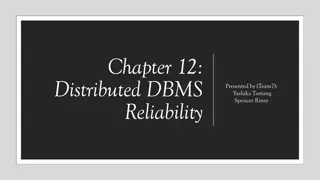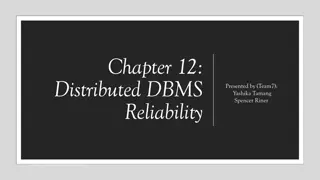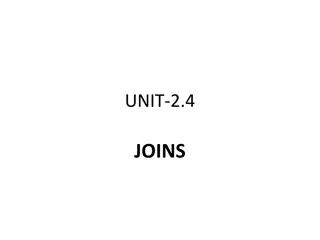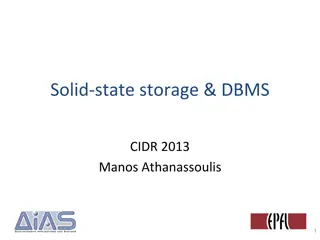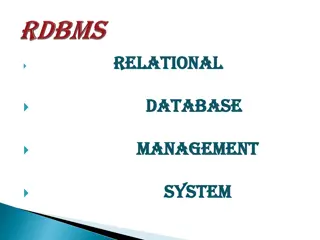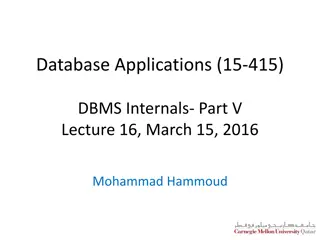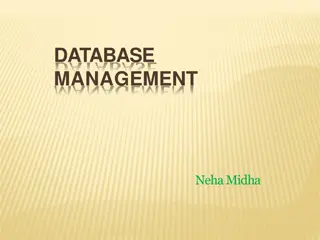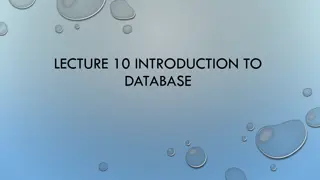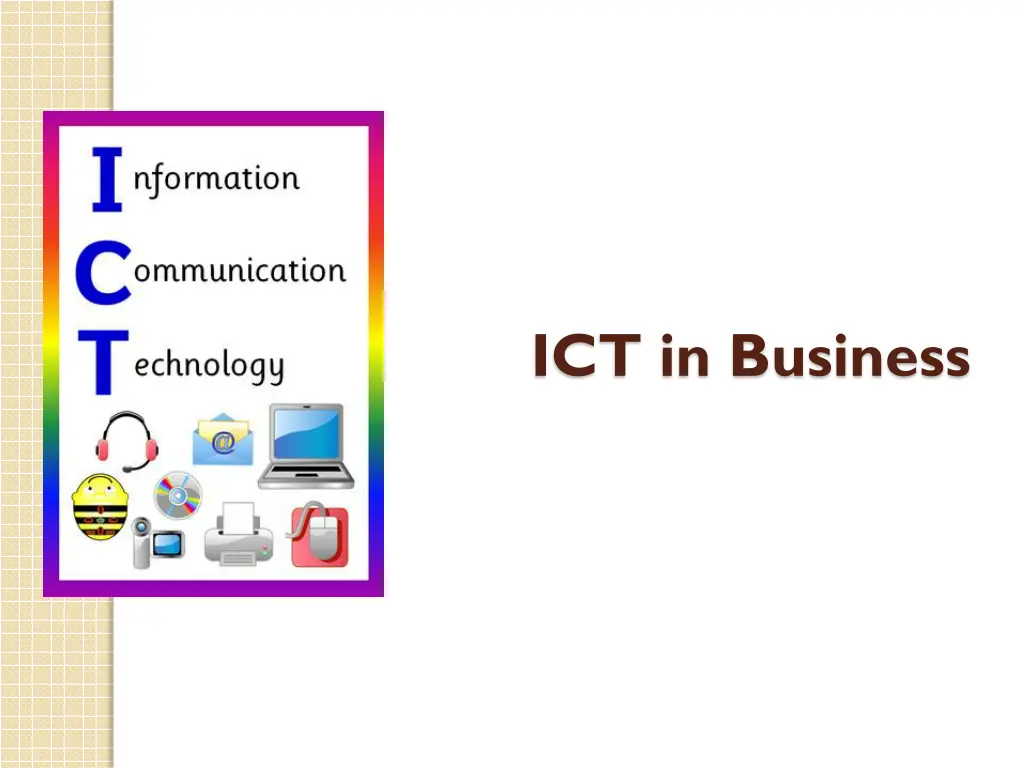
Understanding Basics of Database Management Systems
Delve into the world of Database Management Systems (DBMS) with this comprehensive guide covering the fundamental concepts, components, and applications. Learn about data hierarchy, database organization, and the role of databases in managing information efficiently for businesses. Explore the significance of data in various forms and grasp the essence of structured data storage.
Download Presentation

Please find below an Image/Link to download the presentation.
The content on the website is provided AS IS for your information and personal use only. It may not be sold, licensed, or shared on other websites without obtaining consent from the author. If you encounter any issues during the download, it is possible that the publisher has removed the file from their server.
You are allowed to download the files provided on this website for personal or commercial use, subject to the condition that they are used lawfully. All files are the property of their respective owners.
The content on the website is provided AS IS for your information and personal use only. It may not be sold, licensed, or shared on other websites without obtaining consent from the author.
E N D
Presentation Transcript
Basics of Database Management System (DBMS) .
Learning Objectives In this chapter you will learn about: Basic Concept of Data & Database Components of Database Basic Concept of Database Management System (DBMS) Advantages and Disadvantages of DBMS Applications of DBMS
What is Data? In simple words, data can be facts related to any object in consideration. For example, your name, age, height, weight,etc.are some data related to you. A picture, image, file, pdf, etc. can also be considered data.
Hierarchy of Data Data are logically organized into; Bits (characters) Fields Records Files Databases
Hierarchy of Data Bit (Character) - a bit is the smallest unit of data representation (value of a bit may be a 0 or 1). Eight bits make a byte which can represent a character or a special symbol in a character code. Field - a field consists of a grouping of characters. A data field represents an attribute (a characteristic or quality) of some entity (object, person,place,or event). Record - a record represents a collection of attributes that describe a real-world entity. A record consists of fields,with each field describing an attribute of the entity.
Hierarchy of Data File - a group of related records.Files are frequently classified by the application for which they are primarily used. A primary key in a file is the field (or fields) whose value identifies a record among others in a data file. Database - is an integrated collection of logically related records or files.
What is Database? Database is an organized collection of interrelated data. It is a systematic collection of data. Databases are used for storing, maintaining and accessing any sort of data. They collect information on people, places or things. That information is gathered in one place so that it can be observed and analyzed. Databases can be thought of as an organized collection of information. Let us discuss a database example: University uses a database to store data of student, their personal details, their previous academic information etc. Let us also consider Facebook. It needs to store, manipulate, and present data related to members, their friends, member activities, messages, advertisements, and a lot more. records, current degree
Database Components There are five main components of a database: Hardware: The hardware consists of physical, electronic devices like computers, I/O devices, storage devices, etc. This offers the interface between computers and real-world systems. Software: This is a set of programs used to manage and control the overall database. This includes the database software itself, the Operating System, the network software used to share the data among users, and the application programs for accessing data in the database.
Database Components Data: Data is a raw and unorganized fact that is required to be processed to make it meaningful. Data can be simple at the same time unorganized unless it is organized. Generally, data comprises facts, observations, perceptions,numbers,characters,symbols,images,etc. Procedure: Procedure are a set of instructions and rules that help you to use the DBMS. It is designing and running the database using documented methods, which allows you to guide the users who operate and manage it. DatabaseAccess Language: Database Access language is used to access the data to and from the database, enter new data, update already existing data, or retrieve required data from DBMS.The user writes some specific commands in a database access language and submits these to the database.
What is a Database Management System (DBMS)? Database Management System (DBMS) is a collection of interrelated data and a set of programs to access, manipulate, report and represent those data. The collection of data, usually referred to as the database, contains information relevant to an enterprise. The primary goal of a DBMS is to provide a way to store and retrieve database information that is both convenient and efficient. Database system is designed to manage large bodies of information.
Advantages of DBMS Controls Database Redundancy: All the data is stored in one place, and that recorded in the database and hence controls the redundancy in the database. Improved Data Sharing: An advantage of the database management approach is, the environment in which end users have better access to more and better-managed data.Such access makes it possible for end users to respond quickly to changes in their environment. Increased End-user Productivity: The availability of data, combined with the tools that transform data into usable information, empowers end users to make quick, informed decisions that can make the difference between success and failure in the global economy. Minimized Data Inconsistency: Data inconsistency exists when different versions of the same data appear in different places. The probability of data inconsistency is greatly reduced in a properly designed database. DBMS helps to create an
Advantages of DBMS Better Data Integration: Wider access to well-managed data promotes an integrated view of the organization s operations and a clearer view of the big picture.It becomes much easier to see how actions in one segment of the company affect other segments. Improved Data Security: The more users access the data, the greater the risks of data security breaches. considerable amounts of time, effort, and money to ensure that corporate data are used properly. A DBMS provides a framework for better enforcement of data privacy and security policies. Corporations invest
Disadvantage of DBMS DBMS software and hardware cost is high. DBMS system works on the centralized system, i.e.; all the users from all over the world access this database. Hence any failure of the DBMS,will impact all the users. Setup of the database system requires more knowledge,money,skills,and time. Because of its complexity and functionality, it uses large amount of memory. It also needs large memory to run efficiently. The complexity of the database may result in poor performance.
Applications of DBMS Databases applications are: Banking: For customer information, accounts, loans and banking transactions. Airlines/Railways/Road Transport: For ticket reservation, schedules and routes. Universities: For student information, courses and grades (education management). Credit Card Transaction: For purchases on credit card,monthly statement generation Telecommunication: For keeping generating monthly bills, maintaining balances on prepaid calling cards,storing information about the communication networks. Finance: For storing information about holdings, sales, and purchases of financial instruments such as stocks and bonds.7.Sales: For customer,product and purchase information. are widely used. Some representative records of call made,
Applications of DBMS Manufacturing: For management of supply chains and for tracking production of items in factories, inventories warehouses/stores and order for items. Human Resources: For information about employees,salaries,payroll taxes and benefits and for generation of pay checks. Social Media: For keeping records of user activity. Games: For saving user s progress. of items in
DBMS Software For Personal Computers; MicrosoftAccess FoxPro dBase For Organization Use; Oracle Microsoft SQL Server IBM DB2/DB2UDB Informix Sybase MySQL Ingress Postgre SQL
Data Warehouse and Data Mart Data warehouse: Stores current and historical data from many core operational transaction systems Consolidates and standardizes information for use across enterprise Data warehouse system will provide query, analysis, and reporting tools
Data marts: Subset of data warehouse Summarized or highly focused portion of firm s data for use by specific population of users Typically focuses on single subject or line of business
Big data Big data refers to the large volumes of structured and unstructured data that organizations collect from various sources. The term "big data" encompasses not only the size of the data but also the velocity, variety, veracity, value, and variability of the data. These characteristics are often referred to as the 6Vs of big data.
Big data Volume: Volume refers to the vast amount of data generated and collected by organizations. It includes data from various sources such as social media, sensors, transactions, and more. The massive volume of data requires specialized tools and technologies for storage, processing, and analysis. Velocity: Velocity represents the speed at which data is generated and processed. With the advent of real- time data streaming and IoT devices, data is being produced at an unprecedented rate. Organizations need to capture and analyze data in real-time or near real-time to derive valuable insights and make informed decisions.D
Big data Variety: Variety refers to the diverse types and formats of data that organizations encounter. Data can be structured (e.g., databases, spreadsheets) or unstructured (e.g., emails, social media posts, images). It can come in various formats such as text, audio, video, or log files. Managing and analyzing this heterogeneous data requires advanced tools and techniques. Veracity: Veracity relates to the reliability and accuracy of data. Big data often contains noise, inconsistencies, and errors. Ensuring data quality is crucial for making reliable decisions and drawing meaningful insights. Data cleansing, validation, and verification processes are essential to address data veracity challenges.
Big data Value: Value refers to the ability to extract meaningful insights and derive business value from big data. Analyzing large datasets can uncover patterns, correlations, and trends that can lead to valuable insights, improved decision-making, and competitive advantage. Extracting value from big data requires advanced analytics techniques and data-driven approaches. Variability: Variability signifies the inconsistency and volatility of data over time. Data sources may vary, and the characteristics of the data can change dynamically. Dealing with the variability of data requires flexible and adaptable data processing and analysis methods.

